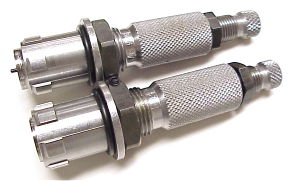 C&H Tool, or CH4D as they are officially known, produced the .358-378RG dies – A set of custom dies, produced exactly to print, delivered on time, without the need for follow up calls. David Davidson runs an exceptional service. The cost for these gems was $160, incredibly inexpensive for custom work from a quality machine shop.
C&H Tool, or CH4D as they are officially known, produced the .358-378RG dies – A set of custom dies, produced exactly to print, delivered on time, without the need for follow up calls. David Davidson runs an exceptional service. The cost for these gems was $160, incredibly inexpensive for custom work from a quality machine shop.
Keep in mind this is a Real Guns purchase, and not a Guns & Ammo project order, which means anyone placing an order with C&H can expect at least the same high level of service. If you have a pleasant personality, probably even better. The full length sizing and seating dies were plopped into Lock-N-Load bushings for use in my RCBS Rock Chucker press. These inexpensive bushings save a great deal of set up time after initial set up. Now I can twist in a set without further adjustment, no matter how often they are pulled and reinstalled.
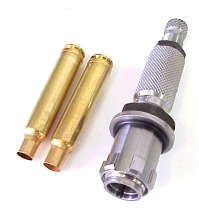 The .358-378 RG is easy to fabricate. The sizer die is installed in the reloading press, a lubed .378 Weatherby Magnum case is installed; one stroke later, .358-378RG brass, almost. The neck reducing step increases the length of the case beyond the intended maximum length spec; 2.916″ rather than 2.913″. After sizing, all brass is trimmed back to 2.903″, or .010″ under maximum length.
The .358-378 RG is easy to fabricate. The sizer die is installed in the reloading press, a lubed .378 Weatherby Magnum case is installed; one stroke later, .358-378RG brass, almost. The neck reducing step increases the length of the case beyond the intended maximum length spec; 2.916″ rather than 2.913″. After sizing, all brass is trimmed back to 2.903″, or .010″ under maximum length.
The neck diameter for the .358-378RG chamber is .392″. The brass will thicken slightly as a result of the sizing operation, so the chamber was cut a hair larger so I won’t have to neck turn cases to achieve a proper clearance. the die turns out a .384″ sized case neck, which increases by about another .002″ when a bullet is seated, leaving a clearance which is about right for field use. As a point of reference, the .378 WM neck is .400″, the .358-378RG is .384″ and the .338-378WM is .370″.
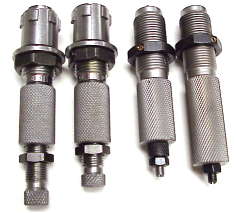 The only possible area of die improvement I could see, might be extending the body on the bullet seating die to allow more travel adjustment for these very long cartridges. In the picture to the left are two sets of dies, the pair on the far left from C&H Tool, the other from RCBS. As you can see, the bullet seating die body from RCBS is about .500″ longer than the RCBS sizer die. This allows the seater plug to be pulled up further from the case. This has no bearing on the quality of assembled cartridges, the longer travel adjustment just makes for a little more convenient assembly. Evident from the picture, the C&H Tool dies are much more substantial than the RCBS dies in all other ways.
The only possible area of die improvement I could see, might be extending the body on the bullet seating die to allow more travel adjustment for these very long cartridges. In the picture to the left are two sets of dies, the pair on the far left from C&H Tool, the other from RCBS. As you can see, the bullet seating die body from RCBS is about .500″ longer than the RCBS sizer die. This allows the seater plug to be pulled up further from the case. This has no bearing on the quality of assembled cartridges, the longer travel adjustment just makes for a little more convenient assembly. Evident from the picture, the C&H Tool dies are much more substantial than the RCBS dies in all other ways.
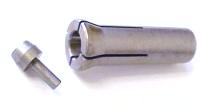 There are always a few more odds and ends required when working with a new caliber. In this case, I needed a .358″ trimmer pilot for use when I bring case length into spec after resizing, and a .35 caliber collet to use when I pull bullets. The oversized .378 WM case will not fit in most conventional inertial pullers. These are a few dollars for each part, so there is no great cash outlay in this area.
There are always a few more odds and ends required when working with a new caliber. In this case, I needed a .358″ trimmer pilot for use when I bring case length into spec after resizing, and a .35 caliber collet to use when I pull bullets. The oversized .378 WM case will not fit in most conventional inertial pullers. These are a few dollars for each part, so there is no great cash outlay in this area.
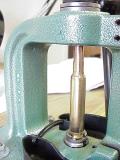 I do most of my large case loading with an Ammo Master Press that can handle up through .50 BMG length cartridges. I can load with the Rock Chucker, but as you can see, it’s a tight squeeze for seating bullets. I tried a few rounds with the RC and the production was okay.
I do most of my large case loading with an Ammo Master Press that can handle up through .50 BMG length cartridges. I can load with the Rock Chucker, but as you can see, it’s a tight squeeze for seating bullets. I tried a few rounds with the RC and the production was okay.
The Weatherby cases based on the .378 WM; .378, .416, .30-378, .338-378, and .460 require some unique accessories ranging from shell holders and shell plates to loading blocks and bullet pullers. In addition, none of the smaller “C” and turret presses will routinely handle these cartridges. It is always best to check before buying.
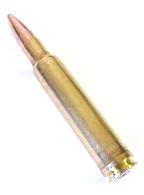 This is an assembled dummy round (no, not named after the assembler) with a 250 grain Barnes X bullet. I’m looking forward to working up handloads for this. “Load From a Disk” version 3.0 was released this week and I’ve already ordered a copy. I’m sure it will prove at least as valuable of a tool as an earlier version, when I was working up handloads for an early manufacture .338-378 Weatherby.
This is an assembled dummy round (no, not named after the assembler) with a 250 grain Barnes X bullet. I’m looking forward to working up handloads for this. “Load From a Disk” version 3.0 was released this week and I’ve already ordered a copy. I’m sure it will prove at least as valuable of a tool as an earlier version, when I was working up handloads for an early manufacture .338-378 Weatherby.
The case has over 130 grains of capacity and I am sure loads will mostly see IMR7828, RL25, H1000 or similar. In fact, I’m hoping much of the material in powders and primers I’ve been using for the .338-378 and .416 Weatherby will serve as a resource pool to draw from for the new cartridge. For the moment, I’m happy I’ve been able to get this far.
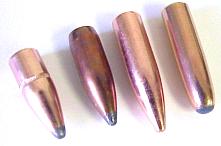 Here we see some of the unusual suspects that will be part of the cartridge wring out. L-R Hornady 200 grain Interlock, Sierra 225 grain Game King spitzer, Barnes X 250 grain spitzer, and a Woodleigh 310 grain round nose soft point. I am also working on some 300+ grain spitzers I did not nail down in time for this article, but they will play a key role during development. The barrel rifling was selected for the longer bullets but, hopefully will work well for all. We’ll see.
Here we see some of the unusual suspects that will be part of the cartridge wring out. L-R Hornady 200 grain Interlock, Sierra 225 grain Game King spitzer, Barnes X 250 grain spitzer, and a Woodleigh 310 grain round nose soft point. I am also working on some 300+ grain spitzers I did not nail down in time for this article, but they will play a key role during development. The barrel rifling was selected for the longer bullets but, hopefully will work well for all. We’ll see.
 I was thinking about how nice it was to receive my CH4D dies on time, when my barrel showed up from Lilja, also on time, also to spec. The barrel, when fitted and trimmed, will be 2″ longer than a standard Ruger No.1 Tropical model, which will make for a still very short rifle. At about 42 1/4″, I’m guessing it will weight about 9 lbs. In this particular case, the difference in felt recoil between an 8 lb and 9 lb rifle is 83 ft/lbs and 73 ft/lbs respectively. Not exactly rim fire rifle territory, but still reduced to a very reasonable 50% greater than the .375 H&H in similar equipment.
I was thinking about how nice it was to receive my CH4D dies on time, when my barrel showed up from Lilja, also on time, also to spec. The barrel, when fitted and trimmed, will be 2″ longer than a standard Ruger No.1 Tropical model, which will make for a still very short rifle. At about 42 1/4″, I’m guessing it will weight about 9 lbs. In this particular case, the difference in felt recoil between an 8 lb and 9 lb rifle is 83 ft/lbs and 73 ft/lbs respectively. Not exactly rim fire rifle territory, but still reduced to a very reasonable 50% greater than the .375 H&H in similar equipment.
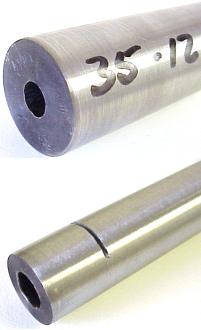 The barrel is of 4140 Chrome Moly, .358 bore, 1:12 twist and 26″ in length. The barrel is 1.25″ at the breech end, tapering to .750″ at the 26″ point. It is unfluted, but may be before it is finished. While classified as a #6 sporter weight, it was held very close to a factory No.1 taper. The barrel ran $230, plus $30 for the Ruger contour.
The barrel is of 4140 Chrome Moly, .358 bore, 1:12 twist and 26″ in length. The barrel is 1.25″ at the breech end, tapering to .750″ at the 26″ point. It is unfluted, but may be before it is finished. While classified as a #6 sporter weight, it was held very close to a factory No.1 taper. The barrel ran $230, plus $30 for the Ruger contour.
As you can see from the breech end, top photo, the barrel needs to be chambered using the custom reamer I purchased from Clymer. The saw cut on the muzzle marks the point of intended useful barrel length. The muzzle will be trimmed to proper length, crowned and fitted with a removable muzzle brake – yes, I am a bench rest coward.
If I could get a stock with the same drop and cast off as my Weatherby’s, I wouldn’t need the brake. I actually learned a lot about recoil from a little 1895G with hot 400 grain handloads. Stock design, correct geometry means everything.
If all goes well, the barrel will be fitted with the factory front ramp sight and quarter rib rear. Then everything will be blued to match and, hopefully, the factory wood will be massaged to fit the new barrel. If the completed gun shoots really well, it will be time for some fancy wood, at least if I have a few bucks left over for the project. If it doesn’t shoot well, it will be used as a jack handle for an Olds Vista Cruiser.
What the heck is next?
Glad you asked. The gun will be packed up and shipped to a gunsmith in the greater Montana area. If the work come out well and to budget, I’ll provide those details. If it doesn’t come out well, I’ll really provide those details. I’m kidding. After a lot of searching, I think I’ve got the right shop and guy for the job.
For those of you who work through this type of thing all of the time, my hat is off to you. It takes a lot of patience and a lot of thought for each step in the process. So far, it feel very good to get this far and to begin seeing real production.
I’ve been very fortunate to get a lot of guidance from Clymer, Lilja, and C&H Tool, which just says a heck of a lot about the level of professionalism that exists within these operations. For a while, during the preliminary stages, the project began to look impossible, or at best unpleasant. I had one person tell me my business expectations were too high for craftsmen; not so. There are lots of good shops out there that perform services at very reasonable costs. What I learned was not to be discouraged, and not to settle for substandard product or service.
I’m having a great deal of fun at the moment, and I’ll update as soon as there is sufficient progress to do so. I believe the next step will be to post drawings for cartridge and chamber as well as some of the anticipated internal and external ballistic projections.
More 358-378RG
The .358-378 RG – Real Guns gets a cartridge
The Ruger No.1 Tropical – The 358-378RG Donor Gun
Real Guns .358-378RG Update and Other Nifty Things
358-378 Real Guns Project Update – What to do when the parts start showing up
The .358-378RG – More Reality than Concept
Handload Data 358-378RG
Thanks,
Joe

Email Notification